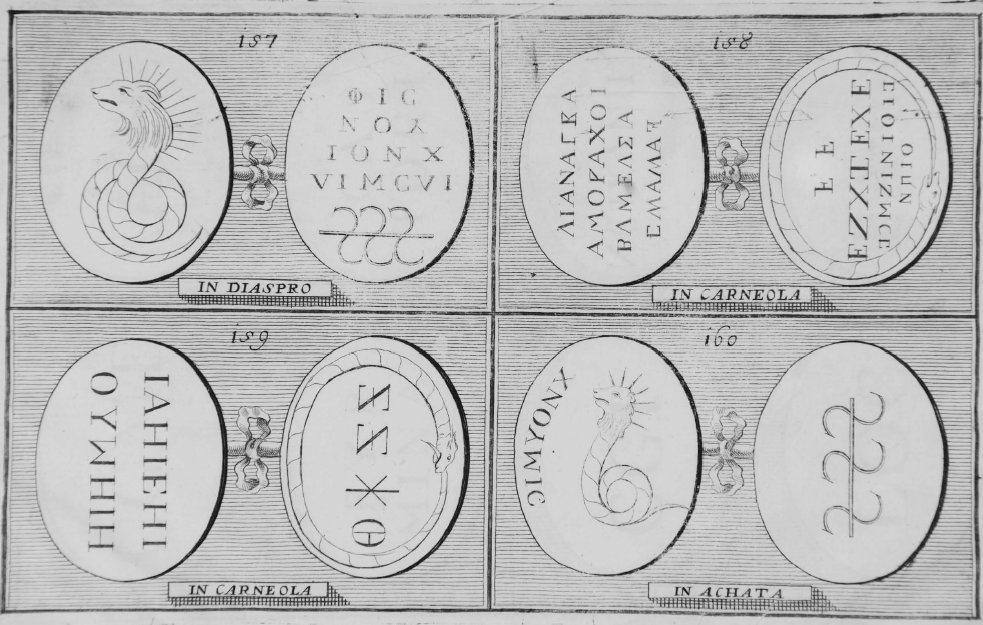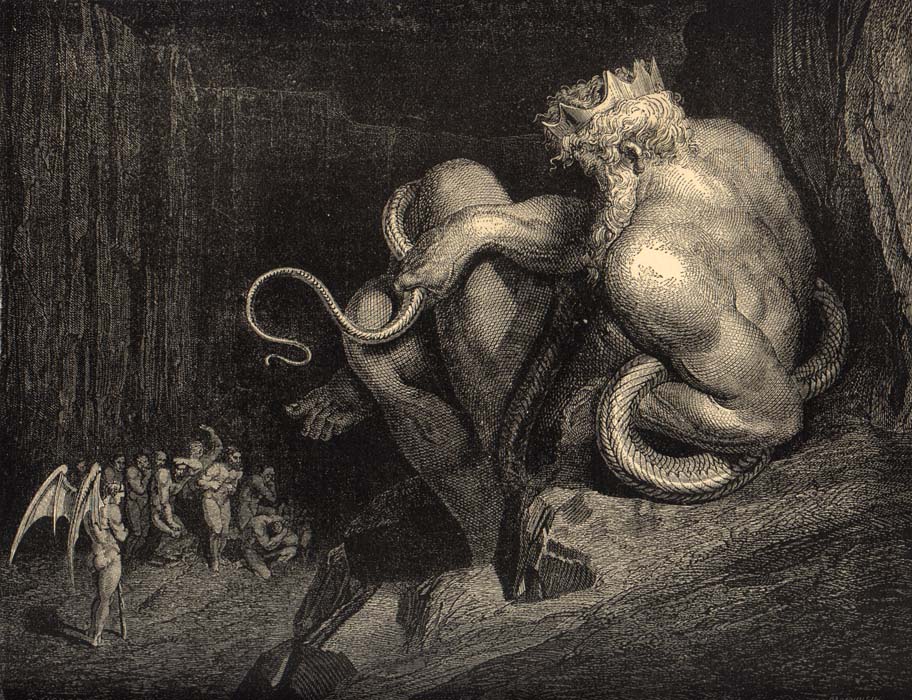Chnoubis is the the Gnostic Agathodaimon (good demon) who is often portrayed in medical amulets and coins as a lion- headed and or man-headed serpent, with two legs, a crown of seven or twelve rays and the tail of a serpent. This demon had always been considered as good and is known to be the driver away of bad demons, and the destroyer of demons.
headed and or man-headed serpent, with two legs, a crown of seven or twelve rays and the tail of a serpent. This demon had always been considered as good and is known to be the driver away of bad demons, and the destroyer of demons.
As I had mentioned in many of my previous articles on demons, the ancient Phoenicians, Greeks and Greco-Egyptians did not consider demons to be all evil and or bad. They had led the belief that there were both good and bad demons who were considered wise and all knowing. Demons who had the power to do good or bad dependent on their free will.
You will also find this demon’s name spelled in various different ways throughout history such as Ξνούβις Khnoubis, Khnoumis Kanobis, Knoubis, Ammon-Chnubis and Ammon-Chnoumis to name a few.
Let me also add that Chnoubis is not really a serpent, but a worm.
 In the early Christian era, the Latin writers for the Catholic Church who had control of history and the secret mysteries had purposely changed all literary references that said worm to the word serpent in order to obfuscate the truth. This is when the King of the earth known as a worm to the ancients becomes that Old Serpent, the Great Dragon who is the Prince of the Earth and who is sometimes called the Devil.
In the early Christian era, the Latin writers for the Catholic Church who had control of history and the secret mysteries had purposely changed all literary references that said worm to the word serpent in order to obfuscate the truth. This is when the King of the earth known as a worm to the ancients becomes that Old Serpent, the Great Dragon who is the Prince of the Earth and who is sometimes called the Devil.
Chnoubis is very similar and or the counterpart to the serpent (worm) deities known as Abraxas, Yaldabaoth and Kneph (Noum, Nu, Nou, Nou-bai, Noub, Nef). The “K” of Kneph is evidently a corrupt addition, as Knoub for Noub; the change of m and b in Noub. There is a striking resemblance between the Semitic nef, ” breath,” and the Coptic nibe, nifi, nouf, ” spiritus; ” and between the hieroglyphic nam (with the article pnum), and the iveS/to, “spirit,” which Diodorus says was the name of the Egyptian Jupiter. He was the ” soul of the world” (comp. “mens agitat molem, et magno se corpore miscet”). (The History of Herodotus)
John Gardner Wilkinson, and Samuel Birch had written in the The Manners and Customs of the Ancient Egyptians; “In the  word Chnoumis, or Nef, we may probably trace the idea of the Spirit of the Deity, if, in his mention of Jupiter, Diodorus had in view the god Chnoumis: Jupiter, he observes, signifying, among the Egyptians, the Spirit, ‘ being the cause of life in animals, and, therefore, the father of all.’
word Chnoumis, or Nef, we may probably trace the idea of the Spirit of the Deity, if, in his mention of Jupiter, Diodorus had in view the god Chnoumis: Jupiter, he observes, signifying, among the Egyptians, the Spirit, ‘ being the cause of life in animals, and, therefore, the father of all.’
The same idea may have led to the Greek and Persian notion, of Jupiter being the air which surrounds the world. ‘ If,’ as I have observed in a previous work, ‘ the sons of Ham taught their descendants, the early inhabitants of Egypt, the true worship of one spiritual and eternal Being, who had disposed the order of the universe, divided the light from the darkness, and ordained the creation of mankind.”
According to Eusebius, the Egyptians represented the Demiurge, or creator of the world, whom they called Kneph, under a human form, covered with blue flesh, encircled by a zone or girdle, holding a scepter, and having on the head a royal ornamented coiffure of feathers. On Egyptian monuments, we find a very similar god alternately known as Amun and Noub who also appears under a human form, with flesh painted blue, invested with a zone, and having his head-dress surmounted by two enormous feathers of different colors. Eusebius also tells us (Praep. et Demonst. Evang. III. ix. 115, Paris, 1628,) that Kneph was represented emblematically under the form of a serpent and his emblem was the Asp.
Sir John Gardner Wilkinson had written further on the connection to Jupiter, “Herodotus, Diodorus, and other writers, in speaking of the Jupiter of Ethiopia, evidently had in view the god Chnoubis; and there is less difficulty in accounting for the notion of his being the same as Jupiter, since he was, if not the king, at least the leader, of the gods.
He corresponded to no other deity of the Greek Pantheon; and the triad of the Cataracts, by uniting him with Sati or Juno, appears to give him a claim to the name of Jove. There is not, however, the same excuse for confounding Chnoubis with Amen, or giving to the latter deity the head of a ram, as his general attribute.”(1)
THE ETYMOLOGY OF CHNOUBIS AND THE GNOSTIC WORM CONCLUSION
In the etymology of Chnoubis which is also spelled Khnoubis, Khnoumis Kanobis, Knoubis, and Cannabis to name a few, we find the words Chn (Ca or Kahn), noub (nef) and the word is.
The first word Chn (Ca or Kahn) we can connect to the Phoenician Hebrew word for priests who are referred to as Cohen, or Kohen and the plural: Cohanim or Kohanim. This etymology I detailed in a previous article, Kohen: The Priest of Baal where I explain that the word kohen or cohen is connected with the the Persic word “Khan”, which is a title of dignity or ruler of a monarchy, and is also translated as king in the East. This is where we get the name “king” in English and other words like Conah, Conan, and Konig.
In many parts of Asia and Europe the words Cane, Cain, Chan, Khan, Kan, or K/iuti, and Cu are used to signify Head, Chief, Prince, and King. This is where we find the connection to kohen. In the Syrian dialect, Kan signifies a prince -, and hence the Almighty is styled (Gen. xiv. 19.). The Mongol dynasty rulers had taken the title of Kaan/Kahn/Khan which is originally a Mongol and subsequently Central Asian title for a sovereign or military ruler, and was also widely used by medieval nomadic Turko-Mongol tribes living to the north of China.
The word noub or nek signifies the spirit or soul of the world which is connected to the as above creator, Jupiter.
The word is means “be, am, or be present.”
Therefor we can say that Chnoubis “is” the head “Priest, Prince, King” of the “Spirit” of the as above Jupiter who is the I AM of the so below.
This deity Chnoubis was created by the Gnostic priesthood of Greco-Egypt and it makes sense that they would encode the words they had used themselves into the deities. After all, they had control of the state religion, mysteries and also the medical establishment.
SOURCES:
1. The Manners and Customs of the Ancient Egyptians, Volume 3 By Sir John Gardner Wilkinson
2. A guide to the third and fourth Egyptian rooms: Predynastic antiquities …By British Museum. Dept. of Egyptian and Assyrian Antiquities,

Moe is the founder of GnosticWarrior.com. He is a father, husband, author, martial arts black belt, and an expert in Gnosticism, the occult, and esotericism.
